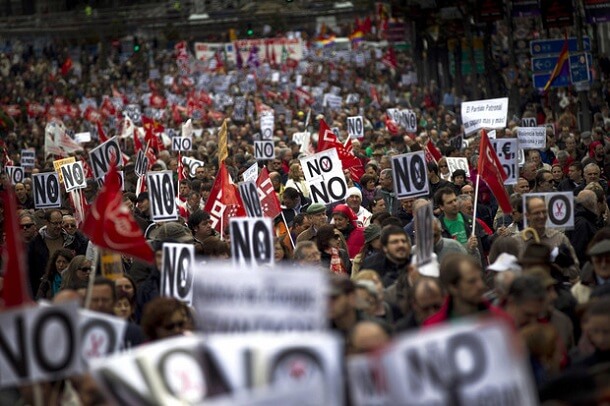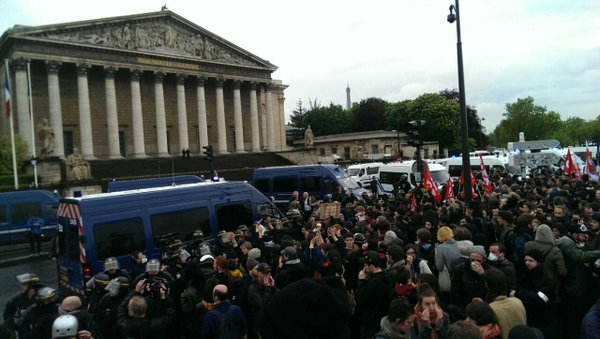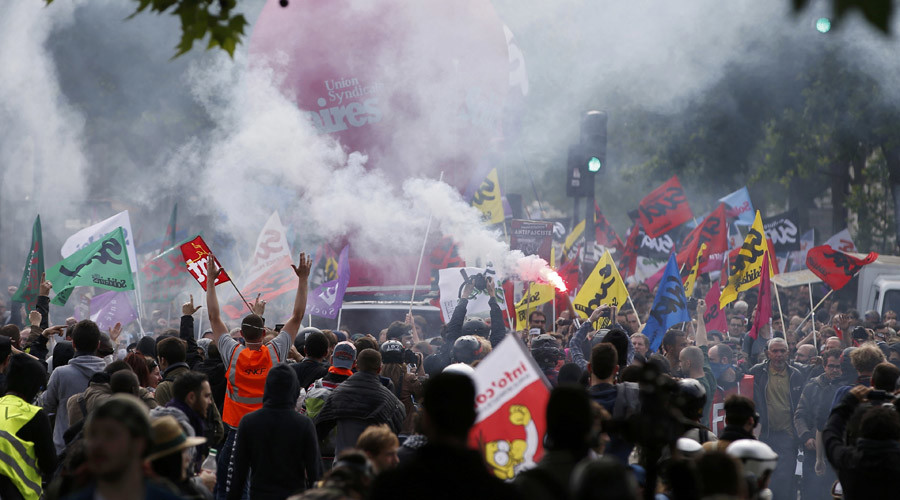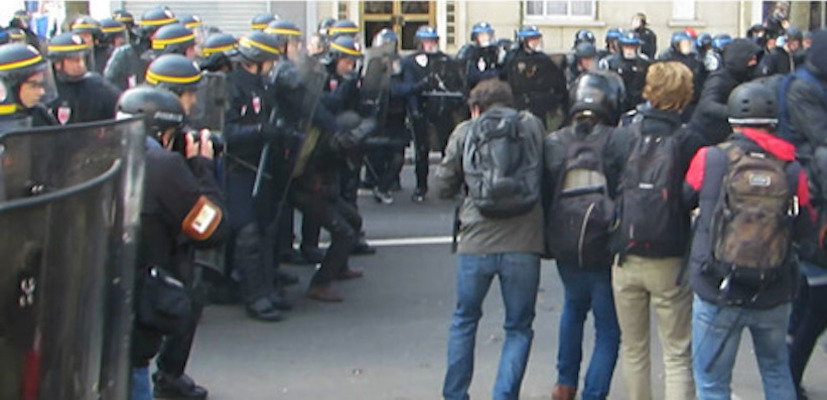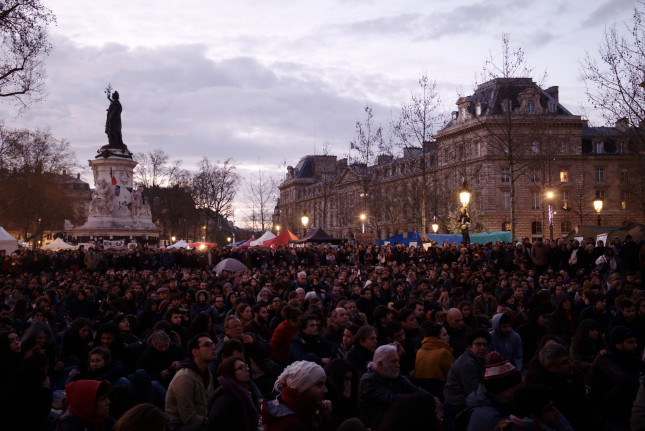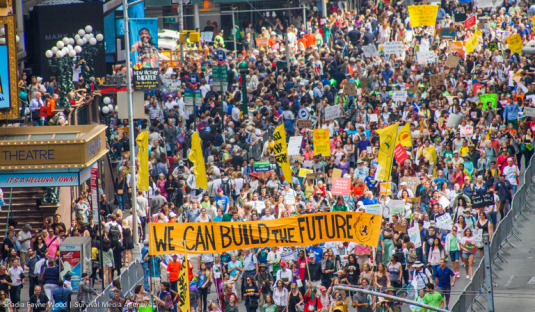By Major Singh
On Friday the 2nd of September 2016 the biggest single strike action in world history took place in India. As many as between 150 and 180 million workers took part in the All India Strike around a 12 point charter of demands put forward by the Central Trade Unions. These included a raise to the minimum wage and pension for all workers, an end to privatization of state owned enterprises and contractorisation of the workforce, a halt to price hikes, the enforcement of labour rights and the scrapping of pro-employer labour law amendments.
This massive show of strength on the part of the working class of India demonstrates that the onslaught against labour rights, by the Modi government and the bosses, and the continued deteriorating living conditions of the masses, will not be taken lying down.
The Centre of Indian Trade Unions (CITU) reported:
“Employees and workers from all sectors of the country’s economy – organised and unorganised, public sector and private sector, central and state government departments, and the scheme workers participated in this strike. In all the strategic sectors of the economy, viz., coal and non-coal mines, electricity, Engineering, petroleum, defence production, telecom and financial sector like banks and insurance etc., the workers and employees took part in the strike in a big way ignoring threats of the respective ministries, managements and also by many state governments.”
We saw many cities around the country brought to a complete standstill as transport and auto workers joined the action in a number of states including Haryana, Punjab, Telengana, Karnataka, Assam, Odisha, Kerala, Tripura and Andhra Pradesh. In fact, in the states of Kerala and Tripura the strike was total and such was the level of support for the strike that CITU reports:
“Though the trade unions did not call for a bandh [a general strike – ed.], a bandh like situation prevailed in many states in the country including Assam, Bihar, Haryana, Odisha, Kerala, Tripura, Telangana, many districts of Karnataka, Madhya Pradesh and others.”
As the old saying goes, “Not a light shines nor does a wheel turn without the kind permission of the working class.” As the events of September the 2nd show such kindness of the working class is wearing thin and it is more and more fighting in a strong way in its own interests. The country was brought to a complete halt showing the real strength of the working class and its potential power when it moves as a whole.
The battle lines are drawn
Preparations for the All India Strike have been taking place within the unions and the left for months now. But as the working class were mobilising their forces so too were the BJP government and the ruling class itself.
View the Telesur picture gallery here
They have tried every trick in the book to try to stop this strike from taking place. The media, courts, police and big business have all lined up behind their government.
Just days before the strike was to take place Arun Jaitley, the Finance Minister, announced some insignificant concessions to the unions. These included a pay rise of 9,100 Rupees to the minimum wage for a section of the workforce, well below the 18,000 that the Central Trade Unions are demanding, and minor changes to bonuses paid to central government employees and other pieces of legislation.
Such measures were rightly considered insulting by many in the trade union movement with Ashok Singh, Vice-President of the Indian National Trade Union Congress, quoted as saying:
“Finance Minister’s statement clearly shows that the government has not considered any of the demands in our 12-point charter. The unions have no other alternative but to fight for their rights.”
The strike went ahead
The fact of the matter is that the government has remained aloof from the trade unions, refusing to even bring them to the discussion table. With the world crisis of capitalism continuing they know they have little to nothing to offer the workers, no concessions that can be sold to them by their leaders, so they prefer to play the game of backroom deals, intimidation and manoeuvres to disorientate the movement.
As the Indian Express reported in August of this year:
“The ministerial panel had met trade unions to discuss their charter of demands on August 26-27, 2015. After that, the panel had only called BMS for two rounds of discussions earlier this month.”
On the 18th of August 2016 a joint declaration of the 10 Central Trade Unions, not including the RSS and BJP affiliated Bharatiya Mazdoor Sangh (BMS), stated:
“It is unfortunate that during the past one year, the group of ministers appointed for discussions with CTOUs (unions) on 12-point charter has not convened a single meeting, but has been only talking to BMS which has not joined the strike call.”
“The CTOUs condemn the move of the central government to divide the workers in the face of ongoing strike campaign and create confusion through making misleading statements…”
The manoeuvres of the BJP government had 2 goals in mind. Firstly, they wanted to divide and weaken the movement and break off some of the weaker more conciliationist elements of the trade union leadership. They were only partially successful in doing this. The BMS dropped their support for the All India Strike in April and declined to take part with the other Central Trade Unions. Whilst this was a terrible betrayal of the working class movement by the leaders of the BMS unions it still nonetheless failed in any meaningful way to negatively impact on the strike.
Secondly, when the BJP proved unsuccessful in halting the strike action, they had planned and organised to do their best to disorganise the workers on the day itself and make the strike a failure. In this of course they had the full support of the state governments, media, courts and police.
The whip of counter-revolution
In West Bengal, Mamata Banerjee and her Trinamool Congress (TMC) government didn’t mince their words saying that the strike would not be allowed to take place in the state. The police and gangs of TMC goons were organised in the districts and areas with plans to break up meetings and assemblies of workers. Striking workers in water transport were even threatened with suspension by the Transport Minister of the state. In the face of such repression, and with 20 demonstrators arrested in West Bengal, the strike remained strong. Even the might of Mamata can not hold back the working class when it moves in such a way.
The courts were used to try to halt the strike with magistrates imposing section 144 of the penal code in several industrial areas including Gurgaon as well as Noida and Faridabad in Haryana. This reactionary piece of legislation, set up during the time of British rule, is in place to prevent “unlawful assembly” of more than 10 people in an area and gives the police the right to disperse any such crowd it sees. This is a right which they chose to use liberally throughout the day on Friday the 2nd of September. Clashes with the police have been reported in Haryana, Uttar Pradesh, Assam, West Bengal and other states.
Even before the strike had begun, in the weeks leading up to it, a pre-emptive sweep was taken of the most militant districts and sections of the working class in order to try to intimidate them. In Gurgaon and other areas, in the residential districts of the workers, the police and their agents circulated warning people to not take part in the strike.
On the night of 1st of September these agents played another role in arresting 12 union leaders of the Maruti Suzuki Workers Union along with 22 leaders of the transport workers union in Gurgaon.
The Hindu reported that in Delhi, “nurses on protest were pushed and bundled into buses and taken into Parliament Street police station” where they were detained for several hours. As the nurses had announced their indefinite strike in government hospitals, later on that day, the Delhi government imposed the Essential Services Maintenance Act (EMSA) on nurses effectively making their strike illegal.
In spite of everything that has been thrown at the workers of India they rose to the occasion on the 2nd of September in a massive show of strength. When the conditions are ripe and the masses begin to move into action not the whip of reaction will more likely embolden the movement than hold it back. Such measures only show the weakness of the bourgeoisie and their complete inability to solve the pressing problems that face the majority of the peoples of India and spur them on to fight in a more resolute manner.
Bold leadership is needed
In an interview after the strike, A. K. Padmanabhan, the President of Centre of Indian Trade Unions said:
“There’s not much difference between UPA and NDA. Neither of them wanted to engage with us. The basic attitude of both these Governments was against the conceding of any of our demands.”
“Clearly, only those who listen to this government will be invited to the table. If this is the attitude of this government, that of creating a wedge between workers and unions and confusing workers, then it is in for a difficult period ahead. Remember that BMS is only one of the 11 recognised central trade unions. The 10 of us together constitute a big force.”
Since the beginning of liberalisation of the economy in 1991 we have seen 17 such strikes take place in India. They have increased in size and frequency in recent years with 12 of these all India strikes happening since 2009. These facts alongside a rise of sporadic political outbursts, such as the recent student movement sweeping India, militant industrial disputes and the re-emergence of unrest in Kashmir demonstrate the depth of the crisis in Indian society and point the way to an intensification of the class struggle in the coming period.
As we explained last year, after the magnificent coal strike:
“One year after taking power, the BJP stands exposed as a government of the bosses and the working class is drawing radical conclusions from all this. In the Coal strike the embryo of a militant national general strike movement was clearly present. The militant actions of the miners immediately struck a chord with the reset of the working class who are looking for a radical way out of the present conditions of exploitation and decay.”
“In the end, the battle against privatisation today cannot be won through isolated strike action alone. So long as the levers of economic and political power remain in the hands of the capitalists, even important victories like that of the Indian coal workers will only provide temporary respite from the onslaught of the ruling class. The struggle of the workers in the Indian coal industry must be raised to a revolutionary struggle against the entire rotten bourgeois system which is threatening the social cohesion of the country as a whole. Thus the struggle against privatisation must eventually be turned into a struggle for the expropriation of the bourgeoisie itself.”
The BJP and the Modi government came to power after a period of vicious attacks by the previous NDA government and a deep crisis in the Communist movement. But as we explained then, far from opening a period reaction, it was the opening shots of a new period of intense class struggle. With the road blocked on the political plane the working class is taking its struggles to the the industrial plane. But in the context of the crisis of capitalism the rotten Indian ruling class is neither capable nor interested in giving concessions. Thus, this movement is merely a forewarnings of the great revolutionary events which are to come in the future.
